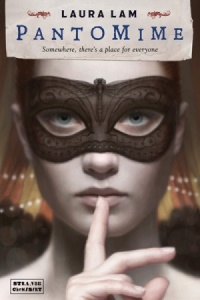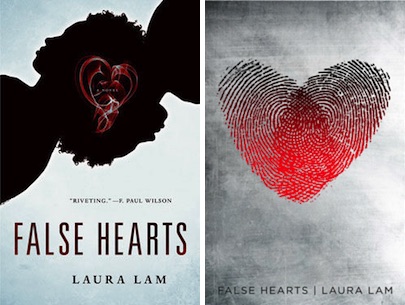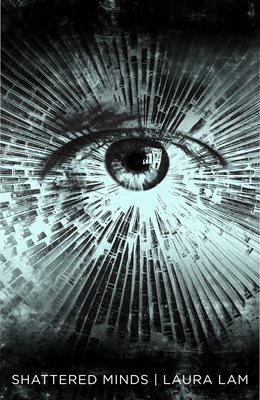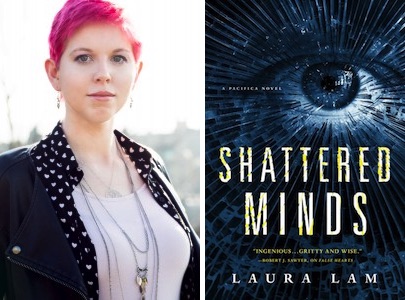Laura Lam’s newest novel, Shattered Minds, is a journey to the exact sort of utopia that I like—namely, a complex, untidy one. Her Pacifica novels explore a future that’s ideal but not idealized and what happens when people fall, or sometimes, jump, between the cracks.
I talked to her about Shattered Minds, Pacifica, the Micah Gray books, and more…
Alasdair Stuart: How did you get started writing?
Laura Lam: I grew up one of the biggest bookworms, and I kept starting various things but never finished. The furthest I got was about 30,000 words of a fantasy based on feudalism. The first line was “The sunset was as red as blood.” It didn’t improve from there.
I started it at 15 at the same time as I met a Scottish boy online in 2002. We fell in love while discussing books and writing those somewhat awful early efforts. I ended up going to university for English Literature and Creative Writing, which taught me to finish work to a deadline. When I moved to Scotland after marrying the Scottish dude in 2009, I had a boring job filing and photocopying, as that was the only job I could get with my English degree at the time. I decided to become more serious about writing and finished a book (Pantomime) in 2011 and sold it in 2012. My method was mostly trial and error.
AS: Which authors inspired you? And continue to do so?
LL: Anyone who knows me at all knows Robin Hobb is my favourite author. False Hearts and Shattered Minds are very different genres to her fantasy (though in Micah Grey, the influence is more obvious), but I think her approach to characterization has stayed with me. I also love cyberpunk, so Gibson and Stephenson mainly, and psychological thrillers are another big inspiration. I read all genres and try to read 100 books a year, though I don’t always make it. As a writer, I feel like reading is such a vital component of my job. I need to know the market, and to see all sorts of ways of putting together stories. I teach on the Creative Writing Masters at Napier in Edinburgh now, too, so I’m also looking at stories from a craft viewpoint for lecturing. Every book I read inspires me in some way, even if it’s not always obvious.
 AS: Tell us a little about the Micah Grey books.
AS: Tell us a little about the Micah Grey books.
LL: The Micah Grey trilogy is Pantomime, Shadowplay, and Masquerade. Short pitch: an intersex, genderfluid, bisexual daughter of a noble family runs away and joins the circus presenting as a male aerialist’s apprentice named Micah Grey. Set in a gaslight fantasy world vaguely based on Victorian Scotland with some Greek mythological influence. Magic that might just be advanced tech in disguise. Stage magic. Court magic. The growing threat of civil war. Returning beings from myth. Found families, friendship, and some romance.
AS: How do the Vestigial Tales series tie in?
LL: They’re largely prequels. “The Snake Charm” is about one of the secondary characters, Drystan, in the Circus of Magic before Micah joins. “The Fisherman’s Net” is a short fable about a mermaid and the dangers of greed. “The Tarot Reader” is another character, Cyan’s, story in the circus she worked in before she’s introduced in Shadowplay, book two. “The Card Sharp” is another story about Drystan, about him being a Lerium drug addict and card sharp before joining the Circus of Magic. “The Mechanical Minotaur” I released this year, and it’s sort of like a non-racist Indian in the Cupboard meets Boy Cinderella, and doesn’t really feature any characters from the main series (but is still best read after Masquerade as a cap to the series).
AS: How did you find the process of producing the Vestigial Tales? How did your process change for the shorter work?
LL: I initially wrote the Vestigial Tales to learn about self-publishing. Pantomime and Shadowplay originally came out through Strange Chemistry, which was the YA imprint of Angry Robot Books. But Strange Chemistry shut down in 2014, and I wasn’t sure what the fate of the series was going to be. I thought it was likely I’d have to release the third myself (I ended up not needing to do this—the rights reverted to me and my agent re-sold them to Tor UK). But before I knew that, to keep myself in the world of Micah Grey, I wrote the stories and had friends help me edit them, another friend made the covers (Dianna Walla, who was my childhood pen pal!), and I formatted them myself. Shorter work obviously requires different plotting and skill. “The Tarot Reader” and “The Snake Charm” are novellas of around 30k, whereas the others range from 5-10k. I really enjoy writing novellas though, as it’s nice and meaty but it’s something that can be read in an afternoon. I’d like to do more of them sometime. The first Vestigial Tale is permanently free if anyone wants to check it out, and it can be read before Pantomime.
Acting as your own publisher is an interesting experience. I already had appreciation for my publishers, but it gave me more. So much goes on behind the scenes, and I think it’d be good for more authors to give self-publishing a go. Hybrid publishing is going to become more popular—I like knowing now that if I have a project I believe in but for whatever reason isn’t appropriate for a trade publisher, I can do it myself and get stories out there. There’s so many ways of doing it now, too. Self-publishing via Amazon and other retailers, releasing work through Patreon, putting things up on Wattpad. It’s an interesting time for publishing.
I didn’t make a huge profit from the short stories, but some money still trickles in every month, and helps me buy lattes when I work in cafes. It was a great experience. I offered two more short stories set in Pacifica for free if readers pre-ordered Shattered Minds this time, and I’ll put them up on Amazon in a few months, too.
 AS: Let’s chat about Pacifica. How does the world of Shattered Minds and the first book, False Hearts, differ from the present day?
AS: Let’s chat about Pacifica. How does the world of Shattered Minds and the first book, False Hearts, differ from the present day?
LL: False Hearts and Shattered Minds are standalones in the same world. They’re set roughly 100 years in the future. Climate change came to a head in 2030-2050, resulting in everyone having to put aside their differences to save the world. That’s the sort of “ghost from the past” that is mentioned but not dwelled on a lot within the books. After the Great Upheaval calmed down, tensions were still high in the U.S. and it fractured. Pacifica is now California, Oregon, Washington, and Hawaii. There’s also the South, The Great Plains, and Atlantica on the East Coast.
Technology is now zooming onwards. People can order pretty much anything from a replicator (yes, stolen from Star Trek. No, no one orders Earl Grey. Not yet at least). Climate change is under control. Self-driving hover cars are common, as well as orchard skyscrapers or glowing algae that makes the Bay shine green at night. People can walk into flesh parlours and change their face and body at will, yet mostly people choose to look blandly beautiful. Crime is very low now and poverty has been eradicated. It should be a utopia in many ways. But it’s not. Scratch the surface and the shine is gone.
AS: There’s a definite kind of Californian futurism which I see in those books—that combination of positivity and hope and almost sun-drenched noir. Where do you think that comes from?
LL: I love the idea of “sun-drenched noir!” It does fall into that a bit.
I don’t think our future will be a complete dystopia. I think it will somewhat like now—lots of good things, lots of terrible things. There’s more equality in this world, monetarily, but those who control data have the most power. Sure, in Pacifica life expectancy is longer, they’ve cured a lot of genetic diseases, and people work fewer hours. But people are still hungry to have more than others, just in different ways. Lots of people will work towards bringing light into others’ lives, but there’ll still be those who thrive on darkness.
Plus, straight up utopias are a lot harder to write about.
AS: Tell us a little about Shattered Minds.
LL: I tend to describe Shattered Minds as female Dexter with a drug problem meets Minority Report. Serial killer becomes addicted to dream drugs so she only kills people in her imagination. When a colleague sends a bunch of encrypted information into her brain before he’s murdered, she’s forced to return to real life and take down an evil corporation with a group of ragtag hackers. It’s about addiction, identity, and overcoming the darkness within.
AS: How does it tie into False Hearts?
LL: False Hearts tends to get the pitch of Orphan Black meets Inception. That one is about formerly conjoined twins. They were raised in a cult, escaped when they were 16, and separated, each fit with a mechanical heart. Ten years later one twin is accused of murder and the other twin has to go undercover into the organised mob, prove her sister’s innocence, and save her life.
Both books are set in Pacifica. False Hearts is in San Francisco and Shattered Minds is in Los Angeles. So same world, a minor crossover character, but otherwise completely self-contained stories, each looking at a different facet of darkness in Pacifica.
 AS: How are you finding working in a sandbox rather than a series?
AS: How are you finding working in a sandbox rather than a series?
LL: It’s a really nice compromise. I really like the world so I get to keep playing with it, but each story is its own creation. There’s some fun Easter eggs to link them, but otherwise you should, theoretically, be able to pick up any of them and dive right in. If you read Shattered Minds, you will pick up a few things that happened as a result of False Hearts, so it’s probably still best to read them in order, but not essential. It also means there doesn’t have to be a set number, or if there’s a bit of a gap between releases, people aren’t kept hanging like they were with the third book of my trilogy when it changed publishers. That was disappointing for them and vaguely traumatic for me. This is less stress and more fun.
AS: What’s next for you? And for Pacifica?
LL: At the moment, my response is “no comment.” I’m working on a bunch of things, but don’t have any clear idea of what’s happening next. Which is scary, but all I can focus on is the words, so I do that.
Shattered Minds is out now in hardback with the previous novel in the Pacifica sequence, False Hearts, available in paperback. Also available in paperback are Pantomime, Shadowplay and Masquerade. Find Laura online at her website and on Twitter @LR_Lam
Alasdair Stuart is a freelancer writer, RPG writer and podcaster. He owns Escape Artists, who publish the short fiction podcasts Escape Pod, Pseudopod, Podcastle, Cast of Wonders, and the magazine Mothership Zeta. He blogs enthusiastically about pop culture, cooking and exercise at Alasdairstuart.com, and tweets @AlasdairStuart.










